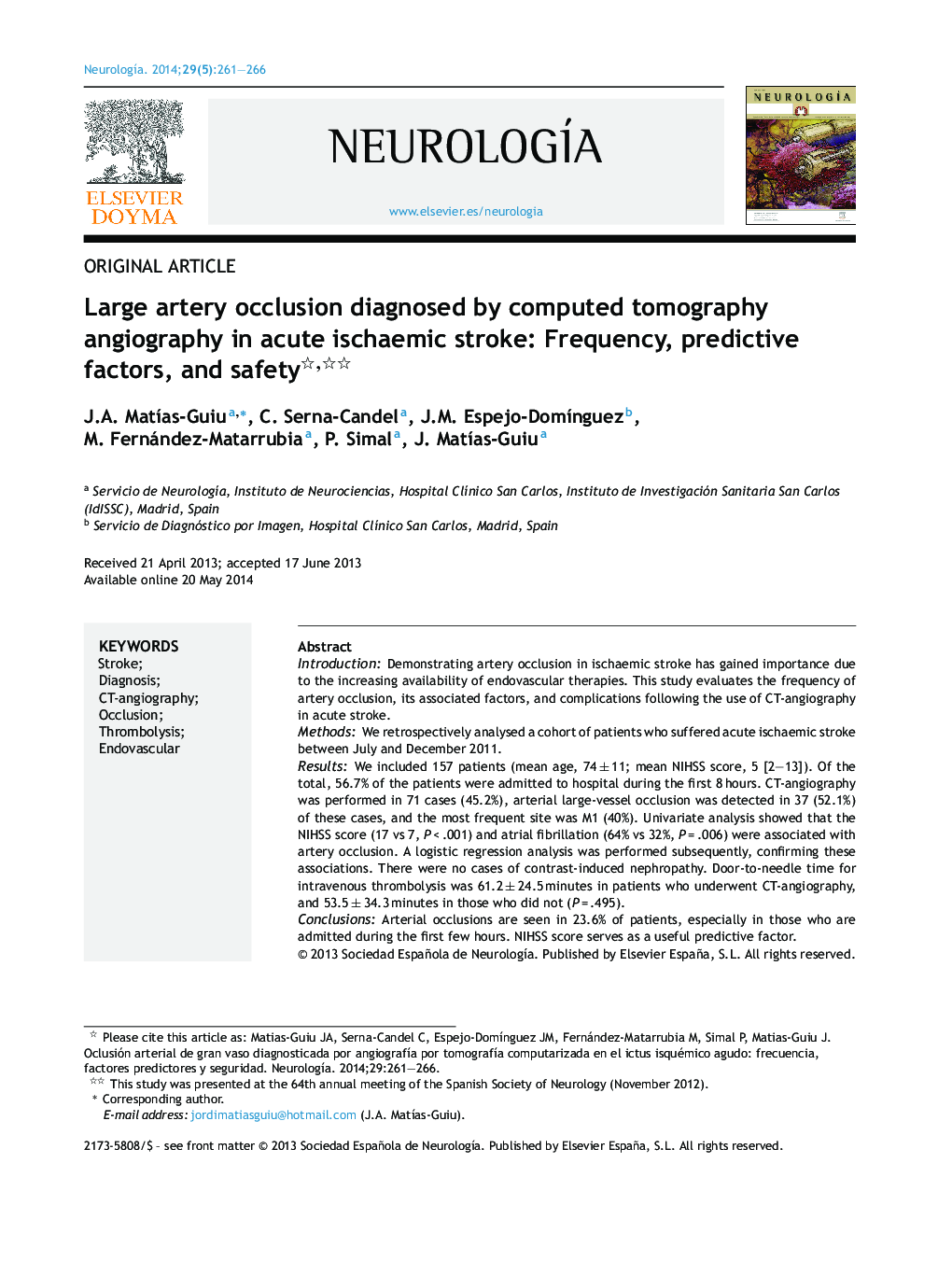| کد مقاله | کد نشریه | سال انتشار | مقاله انگلیسی | نسخه تمام متن |
|---|---|---|---|---|
| 3077212 | 1189128 | 2014 | 6 صفحه PDF | دانلود رایگان |
IntroductionDemonstrating artery occlusion in ischaemic stroke has gained importance due to the increasing availability of endovascular therapies. This study evaluates the frequency of artery occlusion, its associated factors, and complications following the use of CT-angiography in acute stroke.MethodsWe retrospectively analysed a cohort of patients who suffered acute ischaemic stroke between July and December 2011.ResultsWe included 157 patients (mean age, 74 ± 11; mean NIHSS score, 5 [2–13]). Of the total, 56.7% of the patients were admitted to hospital during the first 8 hours. CT-angiography was performed in 71 cases (45.2%), arterial large-vessel occlusion was detected in 37 (52.1%) of these cases, and the most frequent site was M1 (40%). Univariate analysis showed that the NIHSS score (17 vs 7, P < .001) and atrial fibrillation (64% vs 32%, P = .006) were associated with artery occlusion. A logistic regression analysis was performed subsequently, confirming these associations. There were no cases of contrast-induced nephropathy. Door-to-needle time for intravenous thrombolysis was 61.2 ± 24.5 minutes in patients who underwent CT-angiography, and 53.5 ± 34.3 minutes in those who did not (P = .495).ConclusionsArterial occlusions are seen in 23.6% of patients, especially in those who are admitted during the first few hours. NIHSS score serves as a useful predictive factor.
ResumenIntroducciónCon la creciente disponibilidad de las terapias endovasculares, la demostración de oclusión arterial en el ictus isquémico agudo ha cobrado mayor relevancia. Este estudio evalúa la frecuencia de oclusión arterial y los factores asociados a la misma, así como las complicaciones derivadas del uso de angio-TC en el ictus agudo.MétodosSe analizan retrospectivamente a los pacientes con ictus isquémico entre el 1 de julio y el 31 de diciembre del 2011.ResultadosCiento cincuenta y siete pacientes (edad media de 74 ± 11 años, NIHSS 5 [2–13]). Un 56,7% llegó al hospital con menos de 8 h de evolución. Se realizó angio-TC en 71 casos (45,2%), detectando oclusión de gran vaso en 37 (52,1%). La localización más frecuente fue M1 (40%). En el análisis univariante se halló asociación de la escala NIHSS (17 vs. 7, p < 0,001) y la fibrilación auricular (64% vs. 32%, p = 0,006) con la presencia de oclusión arterial. Posteriormente, se realizó una regresión logística, confirmando dicha asociación. No se observó ningún caso de nefropatía por contraste. El tiempo puerta-aguja para fibrinólisis intravenosa fue de 61,2 ± 24,5 min en los pacientes en que se realizó angio-TC y 53,5 ± 34,3 en los que no se realizó (p = 0,495).ConclusionesLa oclusión de gran vaso se detecta en el 23,6% de la muestra, especialmente en los pacientes traídos en las primeras horas. La escala NIHSS es un buen factor predictor.
Journal: Neurología (English Edition) - Volume 29, Issue 5, June 2014, Pages 261–266
